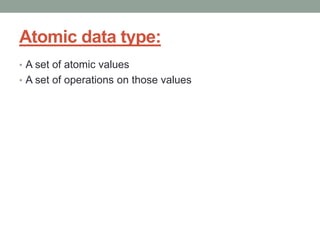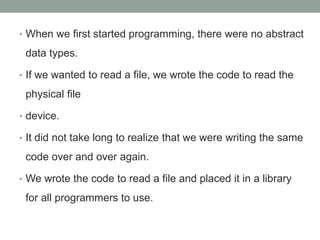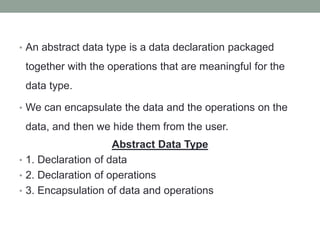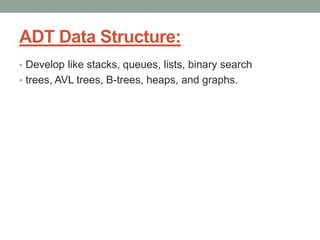Data structure Unit-I Part A
- 1. DATA STRUCTURE Unit – I Part A
- 2. Syllabus: • Introduction: • Pseudo code • Algorithm Header • Purpose, Conditions, Return • Statement Numbers • Variables • Algorithm Analysis • Statement Constructs • Pseudo Example
- 3. • The Abstract Data Type • Atomic and Composite Data • Data Structure • Abstract Data Type • A model for an Abstract Data Type • ADT Operations • ADT Data Structure • ADT Class Templates • Algorithm Efficiency • Linear Loops • Logarithmic Loops • Nested Loops • Big-O Notation • Standard Measures of Efficiency • Big-O Analysis Examples
- 4. • Searching: • List Searches • Sequential Search • Sequential Search Algorithm • Variations on Sequential • Searches • Sentinel Search • Probability Search • Ordered List Search • Binary Search • Target Found • Target Not Found • Binary Search Algorithm • Binary Search Algorithms • Analyzing Search Algorithms • Sequential Search • Binary Search
- 5. • Hashed List Searches • Basic Concepts • Hashing Methods • Direct Method • Subtraction Method • Modulo-division Method • Digit-extraction Method • Midsquare Method • Folding Methods • Rotation Method • Pseudorandom Hashing • One Hashing Algorithm • Collision Resolution • Open Addressing • Linear Probe • Quadratic Probe Pseudorandom Collision • Resolution • Key Offset • Linked List Resolution • Bucket Hashing • Combination Approaches • Hash List Example
- 6. Pseudo Code: • Several tools are used to define algorithms, one of the most common is pseudo code. • It is an English like representation of the code required for an algorithm. • It provides a related syntax that is easy to read.
- 7. Pseudo code • It is a compact and informal high-level description program. • { • pseudo = imitation or false, • code = instruct written in program language • } • It is used for planning a program • It is also called as Program Design Language (PDL).
- 8. • Logical Structure of Pseudo code: • Sequence logic • Selection logic • Iteration logic • One of the most common tools for defining algorithms is pseudo code, which is part English, part structured code.
- 9. • This data definition describes a node in a self- referential linked list that consists of a nested structure (data) and a pointer to the next node (link).
- 10. Algorithm:
- 14. Algorithm Header: • Each algorithm begins with a header that names it, describes its parameters, and lists any pre and post conditions. • Important because the programmer using the algorithm often sees only the header information, not the complete algorithm.
- 16. Purpose: • It is a short statement about what the algorithms does. • It needs to describe only the general algorithms processing. • It should not attempt to describe all of the processing.
- 17. Conditions: • Precondition: • It lists any precursor requirements for the parameters. • Postcondition: • It identifies any action taken and the status of any output parameters.
- 18. Return: • If a value is returned, it will be identified by a return condition. • Often there is none, and no return condition is needed.
- 19. Statements Numbers: • They are numbered using an abbreviated decimal notation in which only the last of the number sequence. • It is shown on each statement. • End/Exit conditions: • The end of the selection is indicated by the end. • The end of the loop is indicated by end statement/loop.
- 20. Variables: • It is not necessary to define every variable used in the algorithm, especially when the context of the data is indicated by its name. • The selection of the name for an algorithm or variable goes a long way toward making the algorithm and its coded implementation more readable.
- 21. Rules: Don’t use single character names. • Example: • Variable i and j use in C++ for loops. • There is always a better name. Don’t use generic names. • Example: • Generic names are count, sum, total, row, column and file. Abbreviations aren’t excluded as intelligent data names. • Example: • stuCnt is good abbreviation for studentCount.
- 22. Algorithm Analysis: • Not every line of code is explained. • Rather, the analysis examines only those points that either need to be emphasized or that may require some clarification. • It also often introduces style or efficiency considerations.
- 23. Statement Constructs: • Niklaus Wirth stated that any algorithm could be written with only three programming constructs: sequence, selection and loop. • Our pseudo code contains only these three basic constructs.
- 24. Sequence Statements: • It is a series of statements that don’t alter the execution path within an algorithm. • It is obvious that statements such as assign and add are sequence statements. • It is lies in the structured programming concept. • When an algorithm completes, it returns to the statement immediately after the call that invoked it.
- 25. Selection Statements: • It evaluate one or more alternatives. • If the alternatives are true, one path is taken. • If the alternatives are false, a different path is taken. • The typical selection statement is the two-way selection
- 27. Loop Statement: • It iterates a block of code. • The loop that we use in our pseudo code most closely resembles the while loop.
- 29. Pseudocode Example: • Algorithm deviation • Pre nothing • Post average and numbers with their deviation printed • 1 i = 0 • 2 loop (not end of file) • 1 read number into array[i] • 2 sum = sum + number • 3 I = i+1 • 3 end loop • 4 average = sum / i • 5 print (average)
- 30. • 6 j = 0 • 7 loop (j < i) • 1 devFromAve = array[j] – average • 2 print (array[j], devFromAve) • 3 j = j +1 • 8 end loop • 9 return • end deviation
- 31. The Abstract Data Type: • We started with non-structured, linear programs, known as spaghetti code. • In which the logic flow wound through the program like spaghetti on a plate. • The concept of modular programming, in which programs were organized in functions, each of which still used a linear coding techniques.
- 32. • Data Type: • A set of data • Example: Integer data type – whole numbers in some defined range. • Operations that can be performed on the data • Example: add, subtract, divide, multiply and other operation • Object Oriented Programming: • The latest development in the theory of program design. • The functions are developed around an object, such as a linked list. • Encapsulation: • One of the part of OOPs concept. • It is one of the primary concepts behind the abstract data type. • Abstract data type is implemented in C++ class.
- 33. Data Types: • Atomic data • Composite data
- 34. Atomic data: • They are data that we choose to consider as a single, non-decomposable/inseparable entity. • Example: Integer 4562 consider as a single integer value. • An atomic data type is a set of atomic data with identical properties. • Atomic data types are defined by a set of values and a set of operations that act on the values.
- 35. Atomic data type: • A set of atomic values • A set of operations on those values
- 36. Example for atomic data types: • Integer values:- -2, -1, 0, 1, 2, 765 operation: +,-,*,/…… • Float-point values:- ,……,0.0, 0.1, 2.34, 35.890 operations:+,-,*,/…. • Character values: ‘A’,’B’,……’Z’, ‘a’, ’b’….. operation:+,-,
- 37. Composite data: • The opposite of atomic data is composite data. • It can be broken out into sub-fields that have meeting. • Example: • Your telephone number. • Because the number has three different parts. • First – area code • Second – ph.no is actually two different data items, a prefix consisting of a three-digit exchange • Third – The number within exchange, consisting of four digits. • Prefixes were names such as DAvenport and Cypress.
- 38. Example for composite data types: Data • Values: 09-09-2020 • Separated into day, month & year • Operations: add two data values • subtract two data values
- 39. Data Structure: • A data structure is an aggregation of atomic and composite data types into a set with defined relationships. • Data is a value • Structure is a set of rules that hold the data together. • Otherwise, if we take a combination of data types and fit them into a structure such can define its relating rules. • Example: • Array and record
- 40. Important: • A combination of elements each of which is either a data type or another data structure. • A set of associations or relationships involving the combined elements.
- 41. Array Record Homogeneous sequence of data or data types known as elements Heterogeneous combination of data into a single structure with an identified key. Position association among the elements No association
- 42. Abstract Data Type (ADT):
- 43. • When we first started programming, there were no abstract data types. • If we wanted to read a file, we wrote the code to read the physical file • device. • It did not take long to realize that we were writing the same code over and over again. • We wrote the code to read a file and placed it in a library for all programmers to use.
- 44. • This concept is found in modern languages today. • The code to read the keyboard is an ADT. • It has a data structure, a character, and a set of operations that can be used to read that data structure. • Using the ADT we can not only read characters but we can also convert them into different data structures such as integers and strings.
- 45. • The ADT consists of a set of definitions that allow programmers to use the functions while hiding the implementation. • This generalization of operations with unspecified implementations is known as abstraction. The concept of abstraction means: • 1. We know what a data type can do. • 2. How it is done is hidden.
- 46. Solutions: • We can write a program that simulates the queue our analyst needs. • We can write a queue ADT that can be used to solve any queue problem.
- 47. • An abstract data type is a data declaration packaged together with the operations that are meaningful for the data type. • We can encapsulate the data and the operations on the data, and then we hide them from the user. Abstract Data Type • 1. Declaration of data • 2. Declaration of operations • 3. Encapsulation of data and operations
- 49. ADT Operations: • Types of ADT operations: • Constructors • No preconditions • Postconditions describe the “value” of the ADT instance, by telling what the access functions return • Access functions • No postconditions • Manipulation procedures • Postconditions describe the “value” of the ADT instance, by telling what the access functions return
- 50. ADT Data Structure: • Develop like stacks, queues, lists, binary search • trees, AVL trees, B-trees, heaps, and graphs.
- 52. ADT Class Templates: • Two general components of structure are the data and key identifier. • The data structure is given a template identifier of TYPE which the application programmer must use ADT class us defined. • The template is a key type identifier, KTYPE. • The application programmer must use this type when creating the data structure in the program.
- 53. ADT Class Template Implementation:







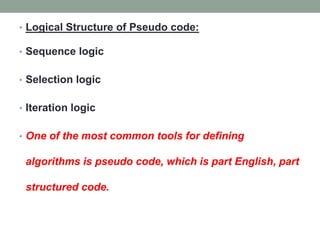




















![Pseudocode Example:
• Algorithm deviation
• Pre nothing
• Post average and numbers with their deviation
printed
• 1 i = 0
• 2 loop (not end of file)
• 1 read number into array[i]
• 2 sum = sum + number
• 3 I = i+1
• 3 end loop
• 4 average = sum / i
• 5 print (average)](https://image.slidesharecdn.com/datastructureunit-ia-200908032659/85/Data-structure-Unit-I-Part-A-29-320.jpg)
![• 6 j = 0
• 7 loop (j < i)
• 1 devFromAve = array[j] – average
• 2 print (array[j], devFromAve)
• 3 j = j +1
• 8 end loop
• 9 return
• end deviation](https://image.slidesharecdn.com/datastructureunit-ia-200908032659/85/Data-structure-Unit-I-Part-A-30-320.jpg)




